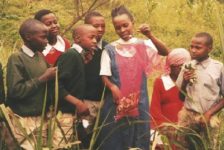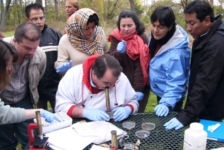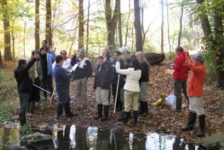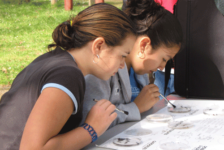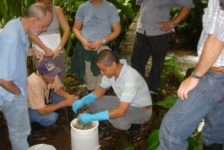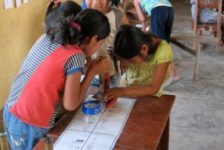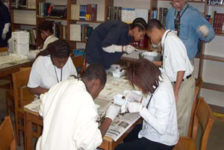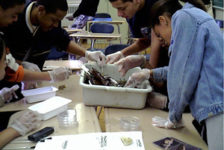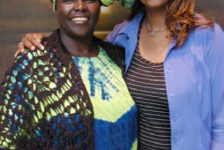In this issue: High Schoolers To Walk Entire Length of NYC Water Supply System!; Leaf Pack in Guatemala; Leaf Pack Goes to Summer Camp; High Schoolers Use Leaf Pack To Teach First Graders.
High Schoolers To Walk Entire Length of NYC Water Supply System!
What does Becca Miner, senior at Sidney High School, have to say about participating in the trek?
“Preserving our environment is one of the most important issues my generation has to deal with. The “Mountaintop to Tap” trek will help many people realize the importance of preserving our watershed so that we don’t lose that which is so vital to life: freshwater.”
In July, six students from New York City and six from the Catskills will explore, on foot and by boat, the city’s drinking water supply from its source near the Catskills’ highest peak to the city. Our goal is to have the students become the agents for educating the public about their drinking water supply, the critical need to protect it, and the vital and little-recognized connections between the city and the upstate watersheds.
The students will chronicle their expedition with photographs and journal entries, after having been trained by National Geographic photographer, Bob Caputo, on how to take pictures that tell a story. The culmination of this trek will be a photo and journal exhibit that will take place this fall at the South Street Seaport Museum in New York City.
Please visit the trek website for more details and send it along to others. Follow the students as they embark on July 7!
Leaf Pack in Guatemala
Guatemala’s only English-speaking magazine, Revue Magazine, ran a cover article on Robert Muller LIFE School’s Leaf Pack project!
“The article describes our efforts to bring the Leaf Pack Network® to local schools and promote conservation,” says principal Franziska Zenhaeusern. LIFE School is located in Panajachel.
“It is our task in our time and generation, to hand down undiminished to those who come after us … the natural wealth and beauty which is ours.” — John Fitzgerald Kennedy, at the dedication of the National Wildlife Federation Building, March 3, 1961.
Leaf Pack Goes to Summer Camp
Have you thought about incorporating a leaf pack experiment into your summer camp or at your nature center? Here are some thoughts on how it worked out for Cornell Cooperative Extension during the summer and fall of 2006.
Dear Leaf Pack,
The leaf packs have been a great tool for several of our programs. During our summer camp we used them for a freshwater class. The leaf packs were set in a local pond and an adjoining stream 1-2 weeks in advance. After retrieving them we were able to distribute what had collected in them into small trays. The children, ages 6-12, used spoons, hand lenses and the sorting sheets that come with the leaf packs to identify the macroinvertebrates they found. Some of the organisms were mounted on slides to be looked at through the microscope, which worked great! It was a fun and interesting activity for the children during our camp program.
This fall we held ten programs involving short nature hikes around either Blydenburgh County Park or Jayne’s Hill in West Hills County Park. Those who attended ranged from pre-school to senior citizens. Several leaf-packs were placed in advance in various locations around each park, either in ponds or streams. During the hikes/walks we talked about the ecology and wildlife of the area, identifying trees, shrubs, plants, animals, birds etc. along the trails. We stopped to collect the leaf packs along the way. At each site we distributed the material collected by the leaf packs into small trays. Spoons and small hand lenses were used to locate organisms. We identified the macroinvertebrates using laminated cards that had been made up earlier in the week from the sorting sheets supplied with the leaf pack kit. Again the participants had a great time finding the organisms. They found the activity interesting and unique.
Overall, the leaf packs have been great! Not only have the participants in our programs enjoyed them, our educators and staff members have as well. They’re easy to use and we’ve had wonderful results every time we’ve utilized them.
Thank you!
Kristin Colavito, Marine Program Assistant Educator
Cornell University Cooperative Extension, Centerport, New York
High Schoolers Use Leaf Pack To Teach First Graders
This spring, Tina Miner-James had her high school Environmental Science class, at Walton Central School in Walton, NY, use leaf packs to teach first graders about water quality and macroinvertebrate identification. Here is a letter from one of her high school students describing the intergenerational teaching experience! The high school students and 1st graders did a great job!
Dear Leaf Pack:
In June 2006, a flood decimated East Brook. The banks were severely eroded and the hillside surrounding the southern slope came tumbling into the brook. In the following weeks, heavy equipment was used up-stream to open the brook back up and to reconstruct the banks. Our question, when placing the leaf packs, was whether or not the brook was back to a healthy state.
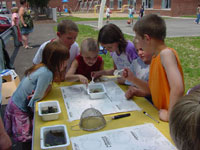
Our Environmental Science class placed three leaf packs in East Brook, two containing mixed leaves and one containing sycamore leaves. After three weeks we collected the leaf packs and identified the macroinvertebrates with first graders at Walton Elementary School. We set up three tables, each with a different leaf pack, and set out magnifying glasses, plastic spoons, and other materials we needed to collect and observe the macroinvertebrates. Our Environmental Science Class was split into three different groups which we replicated for the first graders. We also provided the first graders with coloring sheets to help them learn and understand the macroinvertebrates more clearly.
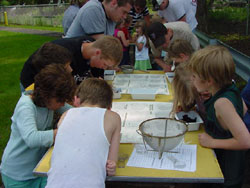
We were surprised at what kind of macroinvertebrates we found. We found many mayflies, caddisflies, and a lot of stoneflies, all of which have a low tolerance to pollution! After collecting and observing the data we had collected with the first graders, we found that the brook was healthier then we expected.
To complete the project, the first graders drew and colored a picture of an insect that we found and we came back to the high School to enter the data onto the network. It was fun working with the first graders. Ms. James and Mr. Breuer hope to do this again next year.
Respectfully submitted,
Shiri Shelton
Walton Central High School
Student, Environmental Science



